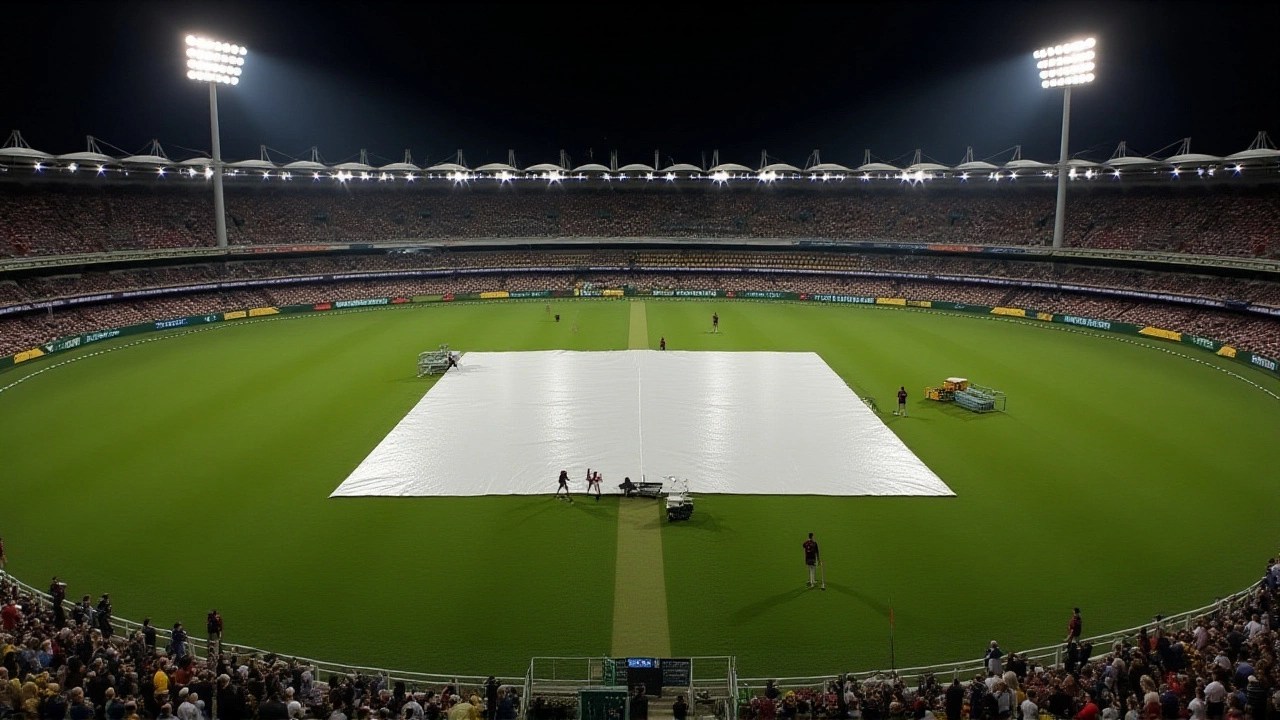When the skies opened up over The Gabba on November 8, 2025, they didn’t just drench the pitch—they sealed India’s series victory before a single Australian batsman had stepped onto the field. With the fifth and final T20I abandoned at 4:24 pm local time after 4.5 overs of India’s innings, the India national cricket team clinched the five-match series 2-1, despite never getting to complete the final game. At the time of abandonment, India stood at 52/0, with Abhishek Sharma smashing 23 off 13 balls and Shubman Gill blasting 29 off 16, both carving boundaries with ruthless efficiency. The rain, accompanied by lightning, rendered the ground unplayable for over two hours. No resumption was possible. And so, the series ended not with a roar, but with a sigh—and a trophy for India.
Series That Wouldn’t Stay Dry
This wasn’t just another washed-out match. It was the second time weather had intervened in this series. The opener at Adelaide Oval on October 28, 2025, had already been called off without a ball bowled. That left Australia with a 1-0 lead after they defeated India by four wickets in the second match on October 30. Then came the turning point: November 2, at Bellerive Oval in Hobart. India chased down 187 with nine balls to spare, thanks to a calm 49* from Washington Sundar and a blistering finish from Jitesh Sharma. Arshdeep Singh’s 3/21 earned him Player of the Match. The fourth game in Carrara Oval on November 6, though not fully detailed, was enough to put India in the driver’s seat—needing only a no-result in Brisbane to win the series. And that’s exactly what they got.Abhishek Sharma: The Quiet Record-Breaker
While the world watched the rain, few noticed the quiet history being made on the pitch. Abhishek Sharma, dropped twice in his first six balls, had already become the fastest batter in T20I history to reach 1,000 runs—doing so in just 576 balls. That record, previously held by Pakistan’s Mohammad Rizwan, was shattered before the skies turned gray. By the end of the series, he’d amassed 163 runs across five matches, averaging 54.33 with a strike rate of 170.6. It wasn’t just about power; it was precision under pressure. When former Australian legend Adam Gilchrist handed him the Player of the Series award, the moment felt symbolic. Here was a young Indian opener, largely overlooked in the global spotlight, outshining Australia’s entire attack.Leadership That Won’t Quit
Behind the scenes, the real story was the consistency of leadership. Under Suryakumar Yadav as captain and Gautam Gambhir as head coach, India has now won five straight bilateral T20I series. That’s not luck. That’s culture. They’ve won in South Africa, England, and now Australia—on pitches that favor pace and bounce, not just spin-friendly tracks. Gambhir’s aggressive mindset, combined with Yadav’s unorthodox shot-making philosophy, has redefined how India approaches the format. Even when the weather denied them the chance to celebrate on the field, the team’s poise was clear. Players stayed behind after the abandonment, signing autographs for kids who’d braved the downpour. That’s the kind of connection that lasts longer than any trophy.What Comes Next?
India’s next challenge is a Test series against South Africa, starting November 14, 2025. That’s a different beast entirely—longer games, tougher conditions, and a side that just won the World Test Championship. Meanwhile, Australia, still reeling from a series loss and a weather-ruined finale, now turns to the Ashes against England. The Ashes begin on home soil in December, and Australia’s batting frailties—exposed by India’s pace attack in this T20I series—will be under intense scrutiny. No one’s saying Australia is broken. But they’re certainly unsettled.Why This Matters Beyond the Scoreboard
This series wasn’t just about wins and losses. It was a statement. India, now undefeated in T20I series since 2023, has built a team that thrives under pressure—even when the pressure comes from the sky. The abandonment at The Gabba, while frustrating for fans, didn’t diminish India’s achievement. It highlighted how modern cricket, with its packed schedules and volatile weather, forces teams to adapt not just tactically, but mentally. Two matches washed out. One won by five wickets. One won by four. And one abandoned. Yet, India still won the series. That’s resilience.Frequently Asked Questions
How did India win the series if the final match was abandoned?
Under ICC rules, if a multi-match series ends with an abandoned game, the winner is determined by the number of matches won. India won two matches, Australia won one, and two matches had no result due to rain. Since India had more wins, they claimed the series 2-1. The abandoned match didn’t count as a win for either side.
What record did Abhishek Sharma break during the series?
Abhishek Sharma became the fastest batter in T20I history to reach 1,000 runs, achieving the milestone in just 576 balls faced—surpassing Pakistan’s Mohammad Rizwan, who had done it in 582 balls. He reached the mark during the final match at The Gabba before the rain halted play, finishing the series with 163 runs across five innings.
Why was the match abandoned and not resumed later?
Lightning strikes in the vicinity forced an immediate evacuation of the field for safety reasons. After the storm passed, heavy, persistent rainfall soaked the pitch and outfield for over two hours, making it unplayable. Ground staff couldn’t dry the surface sufficiently before the scheduled end of play, and with no reserve day allocated for the final match, officials had no choice but to declare it abandoned.
How does this result affect India’s upcoming Test series against South Africa?
The T20I win gives India’s squad massive momentum and confidence, especially in their batting depth and power-hitting. Players like Abhishek Sharma and Shubman Gill, who dominated in short-format conditions, will carry that aggression into Test cricket. However, South Africa’s pace attack—led by Kagiso Rabada and Anrich Nortje—will test India’s ability to adapt to longer spells and tougher conditions, making this a true transition challenge.
What’s the significance of India winning five straight T20I series under Suryakumar Yadav and Gautam Gambhir?
It’s the longest active streak for any Indian captain-coach pairing in T20I history. Before this, the record was four straight series wins by MS Dhoni and Ravi Shastri. This run includes wins in England, South Africa, and now Australia—three of the toughest touring destinations. It signals a new era: India no longer just survives abroad—they dominate, regardless of format or conditions.








Write a comment